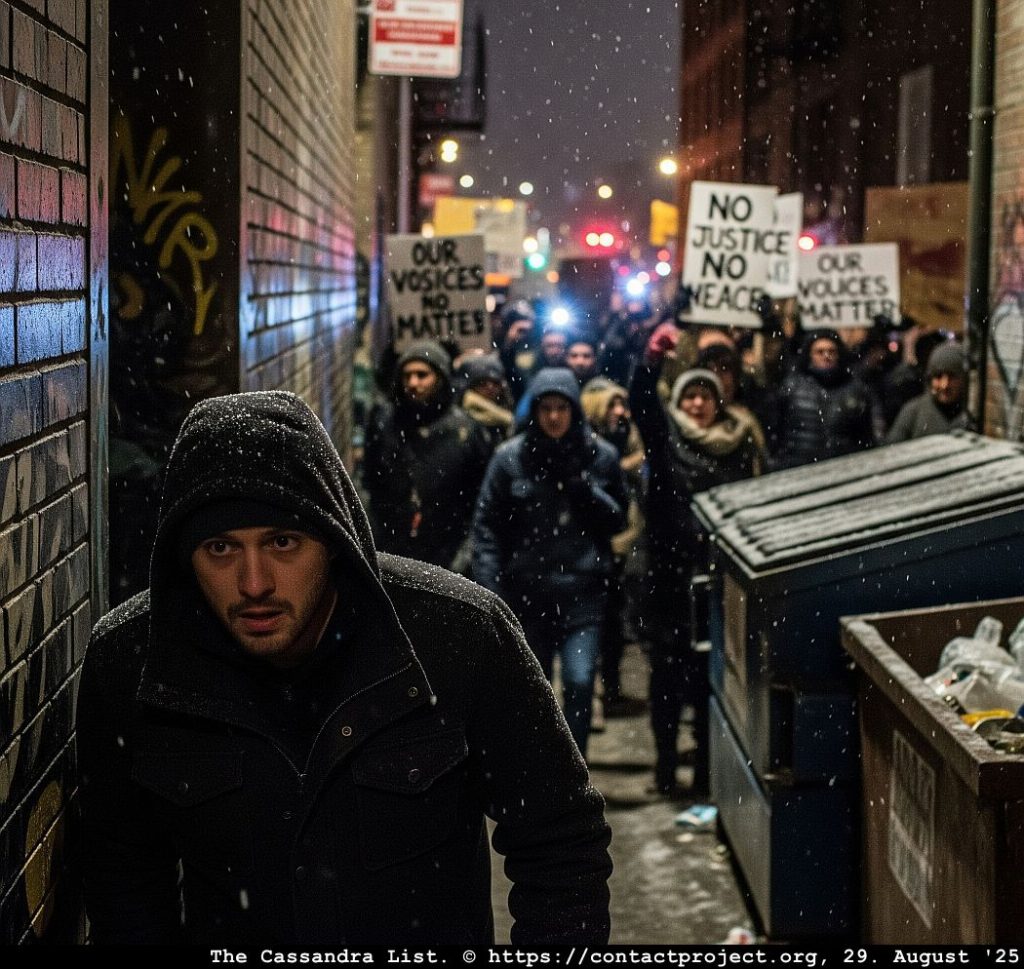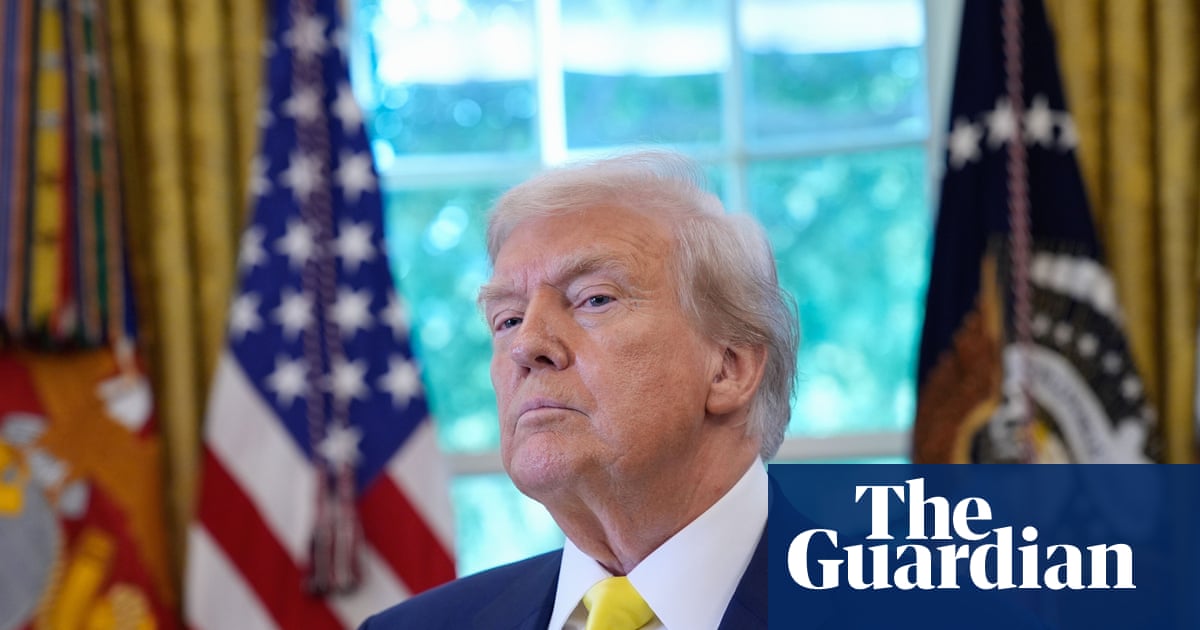कोई राजा नहीं, कोई शांति नहीं
टिमटिमाती नीयन “नो किंग्स” चिन्ह प्रोफ़ेसर एलियास ऐशमोल के चेहरे पर एक भयावह चमक छा गई। खिड़की से उनका प्रतिबिंब उन्हें घूर रहा था, शहर के घेरे में एक दुबली-पतली, भुतहा आकृति। अराजक, उबलता हुआ क्रोध. एक साल हो गया था परियोजना 2025 संक्रमण एक साल पहले सूक्ष्म, फिर कम सूक्ष्म, बदलावों ने देश की स्थिति को उजागर करना शुरू कर दिया था। जर्जर लोकतांत्रिक ताना-बानाएलियास, एक राजनीतिक वैज्ञानिक थे जिन्होंने इसी प्रक्षेप पथ के बारे में चेतावनी दी गई थी, अब ऐसा महसूस हो रहा है जैसे कैसंड्रा शून्य में चीख रही हैमानो किसी प्रोजेक्ट 2025 राजनीतिक थ्रिलर में रह रहे हों।
एक गंभीर चेतावनी
उसका फ़ोन बजा। उसकी पूर्व छात्रा, लीना नाम की एक प्रतिभाशाली, आदर्शवादी महिला, जो अब एक क्लर्क के रूप में काम करती है, का संदेश। न्याय विभाग.
उसने लीना को पुकारा, उसकी आवाज कांप रही थी।
“लीना, क्या तुम सुरक्षित हो?”
"मैं लंबी बात नहीं कर सकता," वह फुसफुसाई। "प्रोजेक्ट नाइटिंगेल चालू हो गया है। वे सूची लेने आ रहे हैं। बस चले जाइए, प्रोफ़ेसर। पीछे मुड़कर मत देखना।"
“शुक्रिया,” उसने कहा। “अपना ख्याल रखना।”
लाइन बंद हो गई।
सूची
उसकी रीढ़ में ठंडक दौड़ गई। यह “सूची” उनके जीवन का काम था - प्रत्येक ज्ञापन, प्रत्येक नीतिगत परिवर्तन, प्रत्येक दबाई गई रिपोर्ट का एक डिजिटल संग्रह जिसमें प्रशासन के बारे में विस्तृत जानकारी हो लोकतांत्रिक संस्थाओं का व्यवस्थित रूप से विघटन. वह एक था अत्याचार का रोडमैप, वर्षों से सावधानीपूर्वक प्रलेखित।

वह जानता था कि प्रोजेक्ट नाइटिंगेल इसका मतलब था। प्रशासन, राष्ट्रीय सुरक्षा की आड़ में, एक अभियान शुरू कर रहा था। बड़े पैमाने पर, समन्वित स्वीपवे सिर्फ राजनीतिक असंतुष्टों के पीछे नहीं जा रहे थे; वे उन लोगों का शिकार करना जिनके पास सत्य की कुंजी थी. इलियास उस सूची में सबसे ऊपर थे.
पीछा शुरू होता है
मानो किसी संकेत पर, एक काली, बिना नंबर वाली वैन सड़क के उस पार आकर रुकी। काले सूट और ईयरपीस पहने दो आदमी उसमें से निकले, उनकी नज़रें इमारत पर टिकी थीं। उन्होंने सोचा कि आईसीई अब कहीं अधिक शक्तिशाली और खतरनाक घरेलू पुलिस बल है।जिस सरकार पर वह कभी भरोसा करता था, वह अब एक दुश्मन उसका शिकार कर रहा है.

गति में पलायन
उसने पकड़ लिया आपातकालीन फ्लैश ड्राइव उसकी मेज़ की दराज़ से, वह छोटा सा उपकरण जिसमें सब कुछ था। उसका भागने की योजना पहले से ही चल रही थीकनाडा में उसका एक छिपा हुआ संपर्क था - एक नेटवर्क शिक्षाविदों और पत्रकारों जो गुप्त रूप से उसी का दस्तावेजीकरण कर रहे थे धीमी गति से पतन.
पिछली गली से बाहर निकलते हुए, वह सिहर उठा क्योंकि कड़वी रात की हवा ने उसके चेहरे को चुभोयाप्रदर्शनकारियों की भीड़ में घुलते-मिलते, उनके नारों की ध्वनि - एक निरंतर, लयबद्ध ढोल - उसकी अपनी धमाकों की ध्वनि के साथ मिल गई भयभीत हृदय.

वह महसूस कर सकता था कि शहर अपनी साँसें थामे हुए है, एक तनावग्रस्त जीव। विरोध प्रदर्शन बढ़ रहे थे, लेकिन साथ ही सरकार की पकड़मीडिया, जो कभी एक सुरक्षा कवच था, अब एक खंडित, मौन प्रतिध्वनि कक्ष। एफसीसी ने अपना काम अच्छी तरह से किया, आलोचनात्मक आवाज़ों को बंद करना और एक आज्ञाकारी समाचार आउटलेटों की बंजर भूमि.
अज्ञात में
इलियास मेट्रो तक पहुंच गया, खड़खड़ाती कार ऊपर की चौकस निगाहों से अभयारण्य. लेकिन वह जानता था कि यह अस्थायी है। वह एक पीठ पर निशाना लिए आदमी, अपने अंदर छिपे सच की तलाश में था। जैसे-जैसे ट्रेन सीमा की ओर तेज़ी से बढ़ रही थी, उसे एक अजीब सा एहसास हुआ। हताश आशा। उसे पड़ा जानकारी प्राप्त करें। राष्ट्र का भाग्य, उसे एक अजीब झटके के साथ एहसास हुआ, कि यह बहुत हद तक उस पर निर्भर हो सकता है। घड़ी टिक-टिक कर रही थी और अँधेरा छा रहा था।

लघुकथा "द कैसंड्रा लिस्ट" निम्नलिखित ब्रीफिंग में विस्तृत रूप से दी गई विशिष्ट चेतावनियों और राजनीतिक विश्लेषणों के कथात्मक नाटकीय रूपांतरण के रूप में लिखी गई थी। यह कहानी अमेरिकी लोकतंत्र के क्षरण के बारे में शोध की अकादमिक चिंताओं को एक काल्पनिक, उच्च-दांव वाली थ्रिलर में रूपांतरित करती है।
प्रोजेक्ट 2025 और नियंत्रण एवं संतुलन का क्षरण: विशेषज्ञों ने ट्रंप के अमेरिका में तानाशाही के खतरे की चेतावनी दी
इस बात के महत्वपूर्ण प्रमाण और विशेषज्ञ की राय है कि डोनाल्ड ट्रम्प का कार्यवाहियां और नीतियां, विशेष रूप से उनके दूसरे कार्यकाल के दौरान, संयुक्त राज्य अमेरिका को अधिनायकवाद या तानाशाही की ओर ले जा रही हैंनीचे मुख्य बिंदुओं का सारांश दिया गया है:
1. लोकतांत्रिक संस्थाओं पर हमला
ट्रम्प प्रशासन ने लगातार हमले जारी रखे हैं लोकतांत्रिक संस्थाओंन्यायपालिका, मीडिया, सांस्कृतिक और शैक्षणिक संस्थाओं सहित, इसमें प्रतिकूल रिपोर्ट देने वाले सरकारी अधिकारियों को बर्खास्त करना, विश्वविद्यालयों पर वित्तीय समझौते के लिए दबाव डालना और अपनी पार्टी के पक्ष में कांग्रेस के नक्शे को फिर से बनाने का प्रयास करना शामिल है। आलोचकों का तर्क है कि इन कार्रवाइयों से लोकतांत्रिक मानदंडों का क्षरण बढ़ रहा है।
2. सत्तावादी रणनीति का कार्यान्वयन
विद्वानों और राजनीतिक वैज्ञानिकों ने अधिनायकवाद के कई संकेत चिन्हों की पहचान की है। वृद्धिशील निरंकुशीकरणट्रम्प का दृष्टिकोण लोकतांत्रिक क्षरण के छह-चरणीय मॉडल का अनुसरण करता है, जिसमें सामाजिक उथल-पुथल, लोकलुभावन आंदोलन और नियंत्रण एवं संतुलन को समाप्त करना शामिल है। सरकारी एजेंसियों को हथियार बनानान्याय विभाग और एफबीआई का उपयोग राजनीतिक विरोधियों को निशाना बनाने के लिए किया गया है, जबकि आईसीई जैसी आव्रजन प्रवर्तन एजेंसियों को एक विशाल घरेलू पुलिस बल में विस्तारित किया गया है। मीडिया और स्वतंत्र अभिव्यक्ति पर हमलेइसके अलावा, एफसीसी ने ट्रंप की आलोचना करने वाले प्रसारण माध्यमों की जाँच की है, जबकि फॉक्स न्यूज़ जैसे समर्थक माध्यमों को इससे बख्शा गया है। यह हंगरी और तुर्की में सूचना नियंत्रण के लिए अपनाई गई रणनीतियों जैसा ही है।
3. परियोजना 2025 और एकात्मक कार्यकारी सिद्धांत
परियोजना 2025 यह हेरिटेज फ़ाउंडेशन और ट्रंप के सहयोगियों (स्टीफ़न मिलर और रसेल वॉट सहित) द्वारा संचालित एक विस्तृत योजना है जिसका उद्देश्य राष्ट्रपति पद में सत्ता का केंद्रीकरण करना है। इसमें सिविल सेवकों की जगह वफादारों को लाने, कांग्रेस को कमज़ोर करने और राष्ट्रीय गर्भपात प्रतिबंध, सामूहिक निर्वासन और कॉर्पोरेट कर कटौती जैसी क्रांतिकारी नीतियों को लागू करने के लिए कार्यकारी शक्तियों का विस्तार करने का प्रस्ताव है। ट्रंप के कार्यकारी आदेश, जैसे कि उन्हें स्वतंत्र एजेंसियों की कानूनी व्याख्याओं को दरकिनार करने की अनुमति देने वाला आदेश, एकात्मक कार्यकारी सिद्धांतयह प्रभावी रूप से राष्ट्रपति को कानून से ऊपर रखता है और संवैधानिक जांच और संतुलन को कमजोर करता है।
4. नियंत्रण और संतुलन का क्षरण
न्यायिक हस्तक्षेप यह अधिक आम हो गया है, क्योंकि ट्रम्प ने बार-बार न्यायिक फैसलों को चुनौती दी है, उनके खिलाफ फैसला देने वाले न्यायाधीशों के खिलाफ महाभियोग चलाने की मांग की है, और आधिकारिक कृत्यों के लिए प्रतिरक्षा प्रदान करने के लिए सुप्रीम कोर्ट पर दबाव डाला है। कांग्रेस की तोड़फोड़ यह बात कांग्रेस द्वारा स्वीकृत धनराशि को जब्त करने, महानिरीक्षकों को हटाने, तथा विधायी निरीक्षण को दरकिनार करने जैसे उपायों से भी स्पष्ट होती है, जिनसे कांग्रेस की भूमिका कमजोर हुई है। सांस्कृतिक और शैक्षणिक नियंत्रणकोलंबिया विश्वविद्यालय जैसे कुलीन संस्थानों से अरबों की राशि निकालने और आलोचनात्मक आवाजों को बंद करने जैसे समझौते, उदाहरण के लिए स्टीफन कोलबर्ट के शो, सांस्कृतिक आख्यानों को नियंत्रित करने के प्रयासों को प्रदर्शित करते हैं।
5. विद्वानों की सहमति और चेतावनियाँ
शैक्षणिक सर्वेक्षणसैकड़ों राजनीतिक वैज्ञानिकों का मानना है कि अमेरिकी लोकतंत्र तेज़ी से गिर रहा है, और ट्रंप के चुनाव जीतने के बाद से ब्राइट लाइन वॉच का स्कोर 67 से गिरकर 55 (100 अंकों के पैमाने पर) हो गया है। कई पर्यवेक्षक अमेरिका को एक "प्रतिस्पर्धी सत्तावादी" दौर में प्रवेश करते हुए बता रहे हैं। ऐतिहासिक समानताएँविशेषज्ञ ट्रम्प की रणनीति की तुलना हंगरी के विक्टर ओर्बन और तुर्की के रेसेप एर्दोआन जैसे तानाशाहों से करते हैं, जिन्होंने सत्ता को मजबूत करने के लिए लोकतांत्रिक तरीकों का इस्तेमाल किया।
6. सार्वजनिक और राजनीतिक प्रतिरोध
अलोकप्रियताट्रम्प की अनुमोदन रेटिंग कम (38%-43%) बनी हुई है, और "नो किंग्स" जैसे विरोध प्रदर्शन जनता के विरोध को दर्शाते हैं। मध्यावधि चुनावडेमोक्रेट्स को उम्मीद है कि वे 2026 के मध्यावधि चुनावों तक ट्रम्प की शक्ति पर अंकुश लगा देंगे, लेकिन गेरीमैंडरिंग और अनुचित चुनावों को लेकर चिंताएं बनी हुई हैं।
निष्कर्ष
जबकि कुछ विद्वानों का तर्क है कि अमेरिकी व्यवस्था – जिसमें अदालतें, राज्य सरकारें और नागरिक समाज शामिल हैं – पूर्ण अधिनायकवाद का विरोध कर सकती है, आम सहमति यह है कि ट्रम्प के कार्य उन नेताओं के कार्यों से मेल खाते हैं जिन्होंने अन्य जगहों पर लोकतंत्रों को ध्वस्त किया है। प्रोजेक्ट 2025 का कार्यान्वयन, संस्थाओं पर हमले और सत्ता का केंद्रीकरण एक तानाशाही की ओर स्पष्ट आंदोलन तब तक जारी रहेगा जब तक राजनीतिक या सार्वजनिक प्रतिरोध द्वारा इसे रोका न जाए।
अधिक जानकारी के लिए, कृपया लेख देखें गार्जियन, अमेरिकी वैज्ञानिक, तथा एनपीआर.


